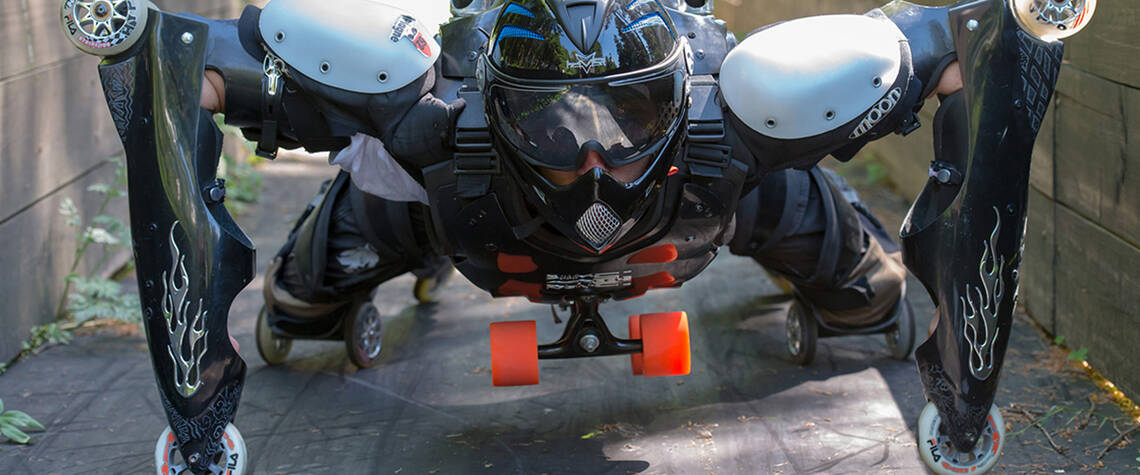
INTERVIEW
"I never wanted to look like a superhero"
Jean-Yves Blondeau hurtles down mountain roads and bobsled runs in rolling armour. A discussion about Hollywood, traffic controls, and RATHGEBER stickers.
Mr Blondeau, are you a big fan of superheroes?
No, not really. As a teenager, I loved comics, but not really the American ones. I didn't like their drawing style and found the plot and characters boring.
Are you aware that you seem like a comic book character in your suit?
Yes. And when I realised that for the first time, I was quite disappointed. My first prototypes were manufactured in 1994. When I got into the suit, I had no idea how I looked. A few days later I held photo prints in my hands - and was shocked. I was speechless, because I never wanted to look like a superhero. I looked at my creation like a father at his wayward son who will not do what Dad wants, but goes his own way.
What was your original plan when you developed the first roll suit?
I was a student at the École Olivier de Serres in Paris, one of the biggest Industrial Design schools in France. The suit was part of my thesis. I wanted to create something that was completely new. Not furniture or a car.
What was the thesis about?
About the connection between the movements of the human body and the emotions and perceptions that arise from them. I surveyed many professional athletes to find out what gives them pleasure and happiness when they play their sport. My goal was to find new ways to discover movements that would bring up powerful feelings. The human body is capable of a lot more than most sports demand of it. There are large gaps where no one is working. I wanted to fill one of the gaps.
"It is the feeling of explosions in your mind. Thousands of pieces of information surge towards you every second."
And so you invented a concept that turns the whole body into a kind of vehicle?
Yes, I wanted to develop a machine with which you can move in all possible positions on the floor. And I wanted to stay close to the body, allow people their identity and to rely on their natural movements. After nine months of research I started the first drawings. The concept was more important to my professor, but for me as a designer ideas are worthless if they do not become reality. So I built the prototype.
What mark did you get?
A good one. I completed my diploma, which only a few people manage at this school.
Have you since become friends with your wayward son?
First I had to discover its potential. Japanese manga helped with this, which were popular in the 90s in France and their plots are more complex than those of American comics. A year or two after my prototype a manga called "Gunnm" came on the market. The heroine has a human head and the body of a robot. In episode six, there is a race in which a cyborg rolls on its back and shows off amazing tricks.
Did you know the author?
No! It was an incredible coincidence. A manga creator and I had the exact same idea at almost the same time. With the difference that in Japan he created a story out of it - and in France I designed a suit.
In your new models they race down roads at 80 km/h - how does that feel?
Hanabi! That's the Japanese word for fireworks. It is the feeling of explosions in your mind. In every second of a trip thousands of bits of information surge towards you. And in a special way: Normally, people stand on their feet which is why we are used to sensations rising through our legs and spine up to the brain. In contrast, if I glide a few centimetres over the asphalt, the impressions go directly to my head. Or they come from the elbows, knees, and chest. I feel the grip through the rollers on my chest when I drift through curves. Every body movement is important. Much like a surfer riding a wave, or a skier who suddenly feels the perfect snow. In a roll suit I have a sense of perfection - with sensations that flow all over me.
You don't stand on the skis, you are the skis?
Yes, something like that. It's awesome.
But when people see you riding, they have the impression that you are moving somewhat unnaturally, robotically.
That's right, you have to plan and execute every move very precisely.
Feeling fireworks in your head and calmly calculating at the same time - is not that insanely stressful?
Not when you have mastered the technique. Then it is exactly that that makes the experience so exciting. The brain switches to a completely unusual mode to, it works much faster than in normal situations - and that's a huge moment. Scientifically speaking: you experience time compression and a space warp. While riding you turn into a kind of cyborg: part human with high emotions, half robot, that is pre-calculating everything precisely.
How hard is it for beginners?
It is like learning to swim. When I first went into the water, water ran into my nose, my eyes, I went under ... Your arm and leg strokes have to be accurate and efficient in order to stay afloat. It is similarly difficult to control how the suit rolls. Some movements go against instinct: For example, if I lean to the left side, my foot and leg system go to the right. You have to reprogramme yourself.
What was your best ride yet?
There have been many. It is extremely fast and almost impossible to st
How fast?
99.9 km/h. Unfortunately I haven't gotten to 100. In a bobsled there are incredible gravitational forces. The pressure makes you feel like a jet pilot. Equally beautiful are the long mountain passes, like the Furka Pass in Switzerland. It's wonderful how the landscape changes from curve to curve from the glacier zone to the valley. It is long, intensive cruising.
How often do you ride on public roads?
Quite often in France. My workshop is in my parents' house, about 20 kilometres from Annecy. If I want to train, I have wonderful mountains just outside the door.
Have you ever come across a traffic check?
Yes, but there is no law that prohibits roll suit riding. It depends a bit on the mood of the police and on how I explain what I'm doing. I follow all traffic rules and explain my suit. Mostly it's okay. Because I'm just as fast on narrow mountain roads as cars, I am not a traffic obstacle. But most of the time I train in an inline skating club to practice new moves. It's amazing, but even at 45 I still discover new ways to move.
Have you had any accidents?
It happens, like it can also happen to a cyclist. But I'm much better protected in my suit. My entire body is wrapped. After a crash, I usually just stand back up with almost no scrapes.
What was your best experience in show business?
Perhaps my first job in Hollywood. I was hired as a stunt trainer for the film "Yes Man" starring Jim Carrey. I was picked up in a limousine and driven to the airport. In LA I had an office in the Warner studios. It was great. Later I worked with Jackie Chan on the film "CZ12". We met in his private bar and did gymnastics on the ground to hone a scene. It was very creative and funny - in the film the sequence was spectacular.
Why did you decide to glue RATHGEBER emblems on your suits?
Since the first prototype in 1994, I have continuously improved the material, the handling, and the technology. I have each carbon part produced expensively. Prominent lettering also upgrades the suits. The emblems must be scratch-resistant, as well as resistant to heat, cold, and rain. I knew that RATHGEBER also produces very high quality for the automotive industry. I chose a variation of flexible plastic that adapts to the curvatures of the suit. For the shoot with Jackie Chan I had no less than ten of the self-adhesive RATHGEBER stickers - Hollywood stuntmen love to destroy everything. And I wanted to be prepared.
How much does one of your suits cost?
The minimum for arms and legs is about 2,000 euros. The complete kit costs 4,000 euros, including the ability to roll on your back.
Are you mass producing your invention yet?
No, the suits are still made piece by piece in my workshop. But demand is growing, and I'm talking with different manufacturers. I have already had to cancel participating in an Olympic opening ceremony because I could not make enough suits for the show team. Currently I am negotiating with a South Korean boy band: they want to use my suits for a music clip. That means five perfect roll suits for the video shoot plus a few for training. A lot of work - but I love it.
Here you can find more informationen on Jean-Yves Blondeau and his suits: www.buggy-rollin.com


